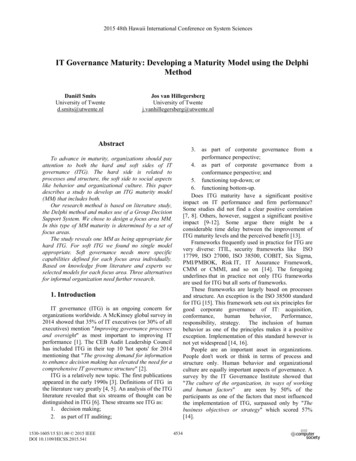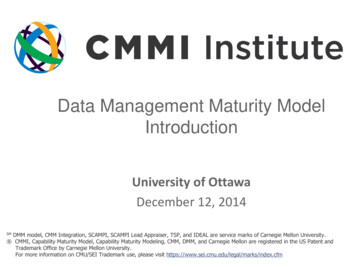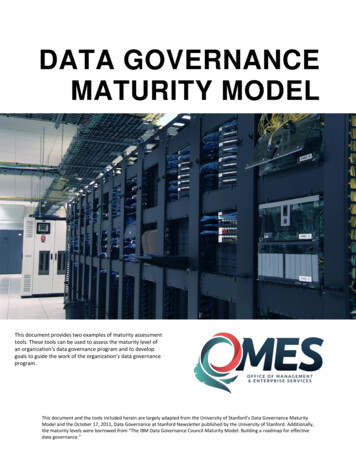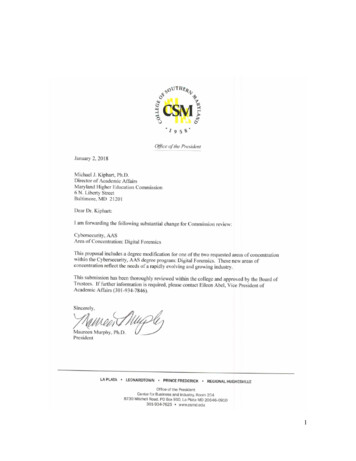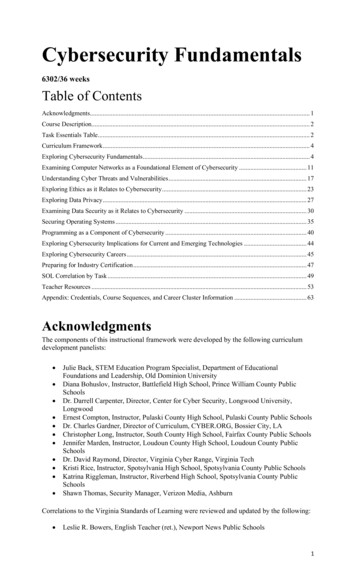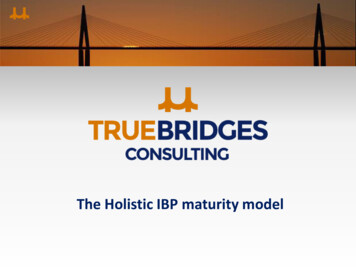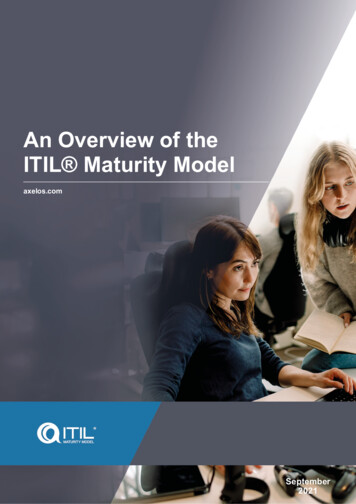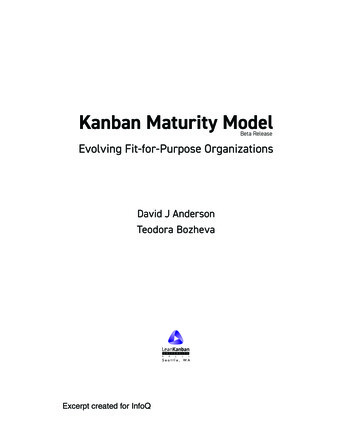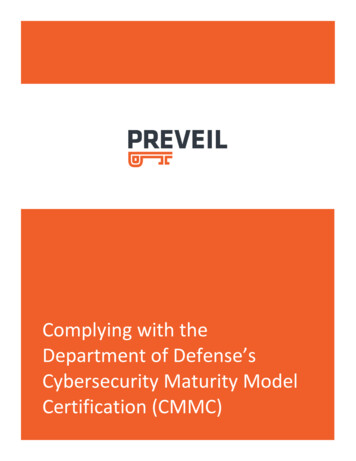
Transcription
Complying with theDepartment of Defense’sCybersecurity Maturity ModelCertification (CMMC)
Complying with the Department of Defense’s Cybersecurity Maturity Model Certification (CMMC)Executive SummaryThe Director of National Intelligence’s annual Worldwide Threat Assessment report has forseveral years identified cyber threats as one of the most important strategic threats facing theUnited States. The Department of Defense (DoD) is keenly aware of the multifaceted cyberthreats our nation faces and has created CMMC to better defend the vast attack surface thatthe Defense Industrial Base (DIB) sector presents to adversaries.DoD is taking a supply-chain risk-management approach to improvingcybersecurity. That means that all 300,000 DoD contractors will needto obtain third-party certification that they meet requirements for theCMMC maturity level appropriate to the work they wish to do for theDoD.Current commercial email and file sharing solutions in the market areinsufficient to comply with CMMC for organizations working withControlled Unclassified Information (CUI). Better alternatives use endto-end encryption to protect data 100% of the time.The Department ofDefense has createdCMMC to betterdefend the vastcyberattack surfacethat the DefenseIndustrial Base sectorpresents toadversaries.This paper provides a high-level overview of the new CMMC framework and its keycomponents. It also answers the pressing question of what your company needs to do tocomply with CMMC and, likewise, work with the DoD. Next, fundamental cyber securityprinciples and how they connect with CMMC are explained. The paper’s final section outlineskey features of PreVeil, an affordable solution to keep your company compliant with DoDregulations.CMMC OverviewCMMC measures an organization’s ability to protect Federal Contract Information (FCI) and CUI.FCI is information not intended for public release and is provided by or generated for thegovernment under a contract to develop or deliver a product or service to the government. CUIis information that requires safeguarding or dissemination controls pursuant to and consistentwith federal law, regulations, and government-wide policies.CMMC combines various cybersecurity standards already in place, and others, and maps thesebest practices and processes to five maturity levels ranging from basic cyber hygiene practicesat Level 1 to highly advanced practices and processes at Level 5.CMMC Model FrameworkThe CMMC model framework categorizes cybersecurity best practices into 17 broad domains,such as “Access Control” and “Systems and Communications Protection.” Forty-three distinctcapabilities, such as “control remote system access” and “control communications at system1
Complying with the Department of Defense’s Cybersecurity Maturity Model Certification (CMMC)boundaries,” are distributed across the 17 domains. Not all companies need to demonstrate all43 capabilities; they apply depending on the maturity level sought.Companies will demonstrate compliance with the required capabilities by showing adherenceto a range of practices and processes. Practices are the technical activities required within anygiven capability requirement; 173 practices are mapped across the five CMMC maturity levels.Processes serve to measure the maturity of organizations’ institutionalization of cybersecurityprocedures; nine processes are mapped across the five CMMC maturity levels.CMMC LevelsCMMC’s five defined levels of cybersecurity maturity, each with a set of supporting practicesand processes, are shown in Figure 1 below. Practices range from basic cyber hygiene at Level 1to advanced and progressive cyber hygiene at Level 5. In parallel, process levels range fromsimply performed at Level 1 to optimized at Level 5.Level 5 - Advanced/ ProgressiveLevel 5 - OptimizedLevel 4 - ProactiveLevel 4 - ReviewedLevel 3 - Good Cyber HygieneLevel 3 - ManagedLevel 2 - Intermediate Cyber HygieneLevel 2 - DocumentedLevel 1 - Basic Cyber HygieneLevel 1 - PerformedProcessesPracticesFigure 1: CMMC Maturity Level DescriptionsNote that DoD contractors must meet requirements for the level they seek in both the practiceand the process realms. For example, a contractor that achieves Level 3 on practiceimplementation and Level 2 on process institutionalization will be certified at the lower CMMCLevel 2.Companies that work with or generate CUI need to achieve CMMC Level3. The DoD explains:An organization assessed at Level 3 will have demonstrated good cyberhygiene and effective implementation of controls that meet the security2
Complying with the Department of Defense’s Cybersecurity Maturity Model Certification (CMMC)requirements of NIST SP 800-171 Rev 11 Level 3 indicates a basic ability toprotect and sustain an organization’s assets and CUI; however, at Level 3,organizations will have challenges defending against advanced persistentthreats (APTs). Note that organizations subject to DFARS Clause 252.204-70122will have to meet additional requirement for Level 3, such as incidentreporting.For process maturity certification, a Level 3 organization is expected toadequately resource activities and review adherence to policy and procedures,demonstrating active management of practice implementation.3CMMC DomainsThe CMMC model consists of 17 domains, shown in Figure 2 below, the majority of whichoriginated from FIPS SP 2004 security-related areas and the NIST SP 800-171 control families.Figure 2: CMMC Model DomainsAccess Control(AC)AssetManagement(AM)Audit andAccountability(AA)Awareness cation andAuthentication(IDA)Incident Response(IR)Maintenance(MA)Media Protection(MP)Personnel Security(PS)PhysicalProtection(PP)Recovery(RE)Risk areness(SA)System andCommunications Protections(SCP)(SCP)System and InformationIntegrity(SII)(SII)1NIST SP 800-171 Rev. 1 refers to a revision of the National Institute of Standards and Technology SpecialPublication 800-171, entitled Protecting CUI in Non-Federal Information Systems and Organizations. It codifies therequirements that any non-federal computer system must follow in order to store, process or transmit CUI orprovide security protection for such systems.2DFARS Clause 252.204-7012 refers to a clause in a Defense Federal Acquisition Regulation Supplement entitledSafeguarding Covered Defense Information and Cyber Incident Reporting. It requires contractors to provide“adequate security” for covered defense information that is processed, stored or transmitted on the contractor'sinternal information system or network.3Cybersecurity Maturity Model Certification Version 0.7, p. 3.4FIPS 200 refers to the Federal Information Processing Standard Publication 200, entitled Minimum SecurityRequirements for Federal Information and Information Systems. It outlines mandatory federal standards forbaseline security controls.3
Complying with the Department of Defense’s Cybersecurity Maturity Model Certification (CMMC)Again, 43 capabilities are distributed across these 17 CMMC domains, and the 173 practicesassociated with those capabilities are mapped across the five CMMC maturity levels.CMMC Process MaturityIn addition to cybersecurity practices, CMMC will measure the maturity of organizations’institutionalization of cybersecurity processes. Level 1 has no maturity requirements related toinstitutionalization. Nine processes indicating increasingly more maturity are mapped acrossthe remaining levels, which can be captured briefly as: Level 1: Performed (but no further process maturity requirements)Level 2: DocumentedLevel 3: ManagedLevel 4: ReviewedLevel 5: OptimizedNote that each required process applies to each domain individually. For example, therequirement that high-level management be informed of any issues within a domain requires17 such formalized processes for doing so (given 17 domains).Finally, adherence to CMMC practices and processes is cumulative. Once a practice or processis introduced in a level, it becomes required for all levels above that as well. Thus, for example,for an organization to achieve Level 3, all the practices and processes defined in Levels 1, 2 and3 must be achieved. DoD Prime contractors must flow down the appropriate CMMC levelrequirement to their sub-contractors, which will vary depending on the nature of thesubcontractors’ work. For example, a prime contractor with CMMC Level 5 certification couldhave a subcontractor with which it shares just FCI; the DoD would require that subcontractorto achieve Level 1 certification.What does my company need to do?All DoD contractors will need to be CMMC certified. One of the most significant changes fromprevious practice is the shift from self-assessment to external assessments of cybersecuritycompliance, which will be conducted by Third Party Assessment Organizations (C3PAOs).Further, whereas in the past noncompliance with DoD security regulations was acceptable aslong as companies prepared POAMS (Plan of Action and Milestones) outlining plans to addressdeficiencies, that will no longer be the case under CMMC.5Clearly, business risk is high any company that does work for the DoD needs to take action.First, if you haven’t already, familiarize yourself with CMMC and stay abreast ofdevelopments. CMMC 1.0 and its helpful, detailed appendicies were released in late January2020 and are available on the DoD's CMMC website.5Companies will still need to complete SSPs (System Security Plans), although those too will not satisfy CMMCrequirements.4
Complying with the Department of Defense’s Cybersecurity Maturity Model Certification (CMMC)Next, determine the appropriate CMMC level for your company. Itappears most likely that companies that handle just FCI will need toachieve Levels 1 or 2. Any company that handles CUI will need toachieve at least Level 3. Higher Levels 4 and 5 will focus on reducingthe risk of advanced persistent threats (APTs) and are intended toprotect CUI associated with DoD critical programs and technologies.If your business hasmigrated to the cloud,standard commercialcloud services such asMicrosoft Office 365and Gmail are notCMMC compliant andso you will need toassess alternatives.Once you determine the CMMC level you want to achieve, examinethe current state of your cybersecurity and identify gaps betweenyour organization’s capabilities and the requirements for the level youseek. This gap analysis could be based on previous self-assessments,such as the NIST SP 800-171 Self-Assessment. However, a moreforward-looking approach would be to consult Appendix A of the CMMC 1.0 report.That appendix includes a summary of the process requirements for each of the five CMMClevels, as well as a matrix that lists each domain's required capabilities and thecorresponding practices for each level.Note that if your business has migrated to the cloud, standard commercial cloud services suchas Microsoft Office 365 and Gmail are not CMMC compliant and so you will need to assessalternatives.As your business considers how to address its cybersecurity deficiencies, keep in mind that withthe adoption of CMMC, cybersecurity will be an allowable cost. This shift recognizes the criticalnature of cybersecurity and serves as an incentive for vendors to quickly comply with CMMC.Begin building budgets for what it will take to upgrade your cybersecurity to the level you needand figure out how those costs will affect your rates.It is crucial to understand that the timetable for implementation of CMMC is rapid. The DoDis aiming to add CMMC requirements to RFPs in October 2020, starting with 15 procurementsfor critical DoD programs and technologies, such as those associated with nuclear and missiledefense. It is expected that approximately 1,500 primes and subcontractors will be affectedand, likewise, will need to be CMMC certified by Fall 2021. The roll-out will continue over afive-year period, with the expectation that all new DoD contracts will include CMMCrequirements by Fall 2026. DoD will identify the required CMMC level in RFP sections L and Mand use responses there as the basis of a “go/no go” decision.5
Complying with the Department of Defense’s Cybersecurity Maturity Model Certification (CMMC)CMMC: Aiming for the Fast TrackDoD is pursuing an aggressive timeline for CMMC, starting with a focus oncritical programs. January 2020: Release of CMMC Version 1.0April to June 2020: Capacity building of third party assessors (C3PAOs)July 2020: C3PAO market place opensOctober 2020: CMMC requirements incorporated into 15 procurements forcritical DoD projects, and used as the basis for “go/no-go” decisions.As of October 2020, the DoD expects that companies seeking to work oncritical DoD programs and technologies will have to be CMMC certified by aC3PAO. This could impact approximately 1,500 primes and subcontractors.You needn’t take on CMMC compliance on your own. Many consulting companies haveadapted their services to address CMMC requirements and can help your company by, forexample, conducting a gap analysis focused on your cybersecurity practices and/or processes.They can also help you build a roadmap for moving forward toward compliance.Technical Cybersecurity Principles and CMMCCybersecurity research at leading universities has led to criticaladvances in applied cryptography. These new technologies, built onthe fundamental security principles outlined below, will enable yourcompany to enhance its cybersecurity and achieve the CMMC levelnecessary to do work for the DoD. Specific CMMC domains addressedby each security principle are noted.End-to-end encryptionNew technologies willenable your companyto enhance itscybersecurity andachieve the CMMClevel necessary to dowork for the DoD.End-to-end encryption ensures that data is encrypted on the sender’sdevice and never decrypted anywhere other than on the recipient’s device. This ensures thatonly the sender and the recipient can ever read the information being shared–and no one else.Data is never decrypted on the server, thus even if attackers successfully breach the server, allthey will get is gibberish.6
Complying with the Department of Defense’s Cybersecurity Maturity Model Certification (CMMC)End-to-end encryption addresses the following CMMC domains: Access Control, ConfigurationManagement, Media Protection, Systems & Communications Protection, and System &Informational Integrity.Encrypted logsAll user activities should be logged in order to trace possible maliciousactivities. Logs themselves also should be tamper-proof and protectedwith end-to-end encryption so that attackers cannot glean informationby viewing log entries, nor can they cover their tracks by deleting logentries.Encrypted logs address the following CMMC domain: Audit &Accountability.End-to-end encryptionenables organizationsto store sensitiveinformation, like CUI,in the cloud becauseinformation is alwayscompletely encryptedon the server.Cloud-based servicesCloud-based services offer significant advantages over on-premises servers, such as lower costs,better scalability, and fewer administrative and maintenance responsibilities. However, manyorganizations have been reluctant to trust sensitive information to the cloud. End-to-endencryption enables organizations to store sensitive information, like CUI, in the cloud becauseinformation is always completely encrypted on the server. Further, the server can never accessdecryption keys. No one but intended recipients can access the data, not even the cloud serviceprovider.Cloud-based services can help address the following CMMC domain: Maintenance & Recovery.Key-based authenticationPasswords create a significant security risk because they are routinelyphished, guessed or stolen. Compromised passwords are used forunauthorized access, escalating privileges, or impersonating a user’sidentity. A much better approach is to authenticate users with privatekeys that are stored only on the user’s device. Unlike passwords, thesekeys cannot be guessed or stolen.Moreover, device-based keys prevent hackers from remotelyaccessing user accounts. Since attackers cannot get to the keys, theycannot access data in users’ accounts. If devices are lost or stolen,device management controls should allow admins to quickly disablethem.Passwords create asignificant security riskbecause they areroutinely phished,guessed or stolen. Amuch better approachis to authenticate userswith private keys thatare stored only on theuser’s device.7
Complying with the Department of Defense’s Cybersecurity Maturity Model Certification (CMMC)Key-based authentication can help address the CMMC domains: Identification & Access, System& Communications Protection, and Systems & Informational Integrity.Administrative distributed trustIn most IT systems, administrators hold the proverbial keys to the kingdom, given that theymost often have access to any user account in the enterprise. As such, they become a focalpoint of attack, and when an attacker compromises the administrator, they gain access to theentire organization’s information.A better approach is to require several people to approve anadministrator’s sensitive activities (such as exporting corporate data).Much like the nuclear launch keys, requiring several people toauthorize critical actions can help prevent malicious activity. Inessence, trust is distributed amongst approvers instead of beingcentralized with one admin. Distributed trust eliminates central pointsof attack.Much like the nuclearlaunch keys, requiringseveral people toauthorize criticalactions can helpprevent maliciousactivity.It’s also important to note that eliminating central points of attack is afundamental means to secure systems. For example, some encryptionsystems centralize the storage of decryption keys in a key server. Doing so undermines thebenefits of encryption because attackers can focus their efforts on penetrating the key server,which if successful would ultimately compromise all of the encrypted data.Administrative distributed trust addresses the following CMCC domains: Access Control andSystems & Communications Protection.Controlled accessMost email and file sharing services are open to anyone, which enables phishing, spoofing, andother kinds of attacks. When an encrypted email and file sharing service is added tocomplement (instead of replace) regular email and files, access can be restricted to only trustedindividuals. These people form a “trusted community” that allows organizations to control theflow of CUI. Individuals outside the trusted community are blocked from sending or receivingencrypted information.Controlled access addresses the following CMMC domains: Configuration Management,Systems & Communications Protection, and Systems & Informational Integrity.8
Complying with the Department of Defense’s Cybersecurity Maturity Model Certification (CMMC)PreVeil Product OverviewPreVeil is based on MIT computer scientists’ research on cybersecurity and appliedcryptography. It adheres to each of the fundamental cybersecurity principles outlined above,beginning with the gold standard of end-to-end encryption to protect email, files and data—even when networks or servers are breached, and administrators are compromised. PreVeil’sencrypted Email and Drive support compliance with virtually all the CMMC mandates relatedto the communication and storage of CUI. (See Appendix A, PreVeil CMMC Level 3 ComplianceMatrix, a table that lists each of the required capabilities for CMMC Level 3 and indicateswhich requirements PreVeil meets.)EmailPreVeil Email lets you send and receive encrypted emails using your existing email address. Itintegrates with mail clients such as Outlook, Gmail, and the Apple Mail, and also works onbrowsers and mobile devices. When PreVeil Email is used with Outlook, Gmail, or Apple Mail,the installation process automatically creates a new set of mailboxes for your encryptedmessages. Messages in these new mailboxes are encrypted and stored on PreVeil’s servers.There are no changes to the mailboxes already in your mail program and no impact on theservers that store your regular, unsecure messages.File sharingPreVeil Drive enables end-to-end encrypted file sharing and storage. Users can access filesstored on PreVeil Drive from any of their devices or share files with other users who havethe appropriate access permissions through PreVeil’s Trusted Communities. Unlike Box,OneDrive, Google Drive, and DropBox, which always have access to your data, only you andthe people with whom you’ve explicitly shared files can decrypt them. PreVeil Drive alsointegrates seamlessly with Windows File Explorer and Mac Finder.Elimination of passwordsInstead of relying on passwords, PreVeil authenticates users via strong cryptographic keysthat are automatically created and stored on users’ devices. Replacing passwords withcryptographic keys shuts down the many significant security risks that flow from phishingand password-guessing attacks, including the use of compromised passwords forunauthorized access and malicious activity. And because the keys are stored are user’sdevices, there is no one central point of attack for hackers to target.Administration consoleUsing PreVeil’s Admin Console, IT administrators can create, modify, and delete users andgroups, as well as set organization-wide data and recovery policies. Device managementcontrols let admins disable lost or stolen devices quickly. Even though all files and emails areencrypted, admins have the tools they need to manage and access their organization’s data.They can view activity logs and decrypt and export user data only with permission from aPreVeil Approval Group.9
Complying with the Department of Defense’s Cybersecurity Maturity Model Certification (CMMC)Cloud-based serviceMany organizations have avoided the cloud, keeping their email and file servers on premisebecause they don’t trust the security of cloud-based solutions. PreVeil’s end-to-end encryptiongives organizations the best of both worlds: end-to-end encryption that is even more securethan on-premise deployments, combined with the cost, scalability and agility of the cloud.PreVeil runs on Amazon Web Services’ Gov Cloud, which provides the foundation for many ofthe controls required to process and store CUI. Again, end-to-end encryption ensures that noone but intended recipients—not even PreVeil or Amazon—an ever access user data.Email and file sharing compliancePreVeil makes it easy to comply with CMMC rules for handling CUI—in contrast to Microsoftand Google services.Microsoft Office 365 does not meet CMMC’s demands for securing email and files. One optionis Microsoft’s GCC High service, which is expensive per user, must be deployed across an entireorganization, and requires a fork-lift upgrade to mail and file servers. Alternatively, PreVeilEmail and Drive address requirements for CUI at a fraction of the cost, can be deployed only tousers who handle CUI, and can be implemented with no changes to existing email and fileservers.Google’s standard Gmail platform also doesn’t comply with CMMC requirements for securingCUI. PreVeil supplements Gmail by adding end-to-end encryption, so neither Google nor PreVeilcan access user data. The PreVeil plug-in for Gmail lets users send and receive encryptedmessages all within the standard Gmail browser app.See Appendix B, Comparison of PreVeil vs. Alternatives, for a comparison of PreVeil andMicrosoft GCC High.Ease of usePreVeil is easy for end users to adopt because it works with the tools they already use. Emailcan be integrated with Outlook, Gmail, or Apple Mail clients. File sharing works like DropBoxand is integrated with the Windows File Explorer and Mac Finder.Cost effectivenessPreVeil’s email and file sharing service is a fraction of the cost of alternatives. Moreover,PreVeil need be deployed only to users handling CUI, whereas alternatives require deploymentacross an entire organization. Finally, PreVeil does not impact existing mail and file servers,making configuration and deployment simple and inexpensive.10
Complying with the Department of Defense’s Cybersecurity Maturity Model Certification (CMMC)ConclusionThe new CMMC framework will better arm the DoD in its efforts to defend against cyberattacksthat threaten U.S. advantages in the military, technological and commercial realms. CMMC’simplementation is on the fast track, and whether your company can continue to work with theDoD will be determined by whether it can achieve the appropriate CMMC maturity level for thecontract you seek. In short, as of October 2020, CMMC certification will serve as the basis ofa “go/no-go” decision for DoD contracts, beginning with those related to critical DoD programsand technologies.All DoD contractors, regardless of size, will need to comply with CMMC requirements. To helpthem do so, PreVeil leverages a fundamentally better security paradigm. But better securityisn’t enough: if security is difficult to use, it won’t be used. To be effective, security must be asfrictionless as possible. PreVeil was created with this principle in mind so that your securityobjectives will be met. It integrates seamlessly with the email and file sharing tools you andyour employees already use.With CMMC upon us, the good news is that PreVeil’s encrypted Email and Drive offeringssupport compliance with virtually all of the CMMC mandates related to the communication andstorage of CUI.PreVeil’s principles: Grounded in the reality of today’s securityenvironment Uncompromising end-to-end encryption—data is never decrypted in the cloudElimination of central points of attack—trust is distributed amongst the adminteamNo more passwords—impossible-to-crack cryptographic keys automaticallycreated insteadSecure activity logs—attackers can neither glean information nor cover theirtracksEase of use—effective security must be as frictionless as possibleTo learn more about PreVeil, visit us at preveil.com/contact.11
Complying with the Department of Defense’s Cybersecurity Maturity Model Certification (CMMC)Appendix A:PreVeil CMMC Level 3Compliance Matrix11
Complying with the Department of Defense’s Cybersecurity Maturity Model Certification (CMMC)Appendix A Summary: PreVeil to CMMC Level 3 MappingCMMC DomainAccess Control (AC)SupportsCompliancePartially Complies ‐AlternativeAdditionalApproach SupportsControls/Compliance (*)ProcessesNecessary (*)15251911Asset Management (AM)Audit and Accountability (AA)Does Not Apply‐Out of ScopeAwareness and Training (AT)3Configuration Management (CM)54Identification and Authentication (IA)46Incident Response (IR)Maintenance (MA)2Media Protection (MP)5Personnel Security (PS)2Physical Protection (PE)6Recovery (RE)Risk Management (RM)211613316Security Assessment (CA)4Situational Awareness (SA)11System and Communications Protection (SC)1216System and Information Integrity *See detailed mapping in Appendix A for explanation.1
Complying with the Department of Defense’s Cybersecurity Maturity Model Certification (CMMC)Note: This CMMC Level 3 (based on v1.02) and NIST 800‐171 controls mapping document contains sample controls only. Please note that some controls are dependent on enterprise policies aligned with thePreVeil information system functionality. This document must not be included as‐is into a System Security Plan. You are responsible for determining which controls are applicable to you, and for developing andmaintaining your own System Security Plan. PreVeil has no responsibility or liability if you choose to include any or all of the sample controls set forth in this document in your System Security Plan.CMMC PracticeAC.1.001AC.1.002CMMC DomainAccess Control (AC)Access Control (AC)Appendix A: PreVeil Email and Drive as a secured enterprise information system for managing U.S. Government CUICMMC PracticeCMMC Practice DescriptionExplanation of Compliance with PreVeilCompliance SupportNIST 800‐171or SourceLimit information system access to authorizedusers, processes acting on behalf of authorizedusers, or devices (including other informationsystems).PreVeil account required to access system. Private, device‐based keyauthentication cyptographically enforces access rights. TrustedCommunity feature eliminates any spoofing or accidentalYescommunication into or out of the system. Device Management provides3.1.1Supports Compliance for control over active devices. Organization‐specified Admin roles andApproval Groups required for invasive Admin actions. PreVeil supportscompliance with this Practice when combined with additional policies,procedures, and/or technologies.Limit information system access to the typesof transactions and functions that authorizedusers are permitted to execute.PreVeil can be deployed for a subset of organization users that needthe highest level of security. File/Folder permissions are enforcedcryptographically. Admin Console only accessible by specified Admins.YesAll system actions are logged. Shared Folders with encrypted contents 3.1.2Supports Compliancecan be restricted to user groups on a need‐to‐know basis. PreVeilsupports compliance with this Practice when combined with additionalpolicies, procedures, and/or technologies.Access to PreVeil is limited to authorized users determined by theorganization. Additionally users can be added/deleted as needed byYesAdministrators. Through a white‐listing process, Trusted CommunitiesSupports Compliance further limits who can access the PreVeil service for an organization.PreVeil supports compliance with this Practice when combined withadditional policies, procedures, and/or technologies.AC.1.003Access Control (AC)Verify and control/limit connections to anduse of external information systems.AC.1.004Access Control (AC)Control information posted or processed onpublicly accessible information systems.AC.2.005Access Control (AC
Complying with the Department of Defense's Cybersecurity Maturity Model Certification (CMMC) 3 requirements of NIST SP 800-171 Rev 11 Level 3 indicates a basic ability to protect and sustain an organization's assets and CUI; however, at Level 3, organizations will have challenges defending against advanced persistent threats (APTs).

